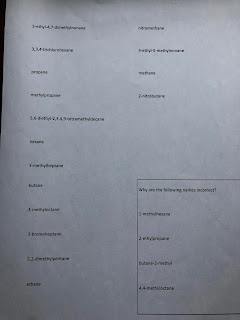All organic compounds are based on C atoms, either linked together in chains or in rings. The C atom is tetravalent, meaning that it will always be surrounded by four bonds (it could be four single bonds, a double and two singles or a triple and one single).
Classification
Organic compounds can be broken into two groups: aliphatic (long or branched C chains/rings, which may or may not include functional groups) and aromatic (compounds based on the benzene ring).
Aliphatic compounds which contain hydrogen and carbon exclusively are known as hydrocarbons. Hydrocarbons can either be saturated (all C-C bonds are single within the compound and thus, the Cs are "saturated" with Hs at every available position) or unsaturated (there is at least one C=C or C𝄘C within the compound and thus, these compounds contain less Hs).
Drawing Organic Compounds
Organic compounds can be illustrated in a variety of ways. Watch this video to see the methods (as well as some other useful information). We will almost exclusively use the skeletal diagrams (aka, line diagrams).
Alkanes
↝ saturated hydrocarbon family (all bonds are C-C single bonds)
↝ general formula: CnH2n+2
The first four prefixes are new ↝ meth (1), eth (2), prop (3) and but (4). After that, the prefixes return to the ones with which we are already familiar ↝ pent (5), hex (6), hept (7), oct (8), non (9) and dec (10). It is possible to have chains with more than ten Cs, but we have enough to worry about. 😃
The compounds above are referred to as "straight chain" hydrocarbons because they have no branches or substituents.
Structural Isomers
Structural isomers consist of compounds with the same formula, but different structures.
Imagine having a bucket of Legos. Given only the instruction to build something, as long as all the Legos were used, you could construct several unique objects. This is exactly how isomers work - using all the C and H available, you could create many different compounds.
Example: For the formula, C6H14, draw and name all the unique isomers.
Answer: Using the drawings below, follow long with this video.
Naming Branched Hydrocarbons
The compounds below are called "branched" or "substituted" compounds because they have bits hanging off of the main C chain.
Branches can be C in nature ↝ methyl (-CH3), ethyl (-CH2CH3), propyl (-CH2CH2CH3), butyl (-CH2CH2CH2CH3), etc.
They can also be non-C in nature ↝ fluoro (-F), chloro (-Cl), bromo (-Br), iodo (-I) or nitro (-NO2).
Always use the following method to name these compounds:
Branches can be C in nature ↝ methyl (-CH3), ethyl (-CH2CH3), propyl (-CH2CH2CH3), butyl (-CH2CH2CH2CH3), etc.
They can also be non-C in nature ↝ fluoro (-F), chloro (-Cl), bromo (-Br), iodo (-I) or nitro (-NO2).
Always use the following method to name these compounds:
- Locate the longest C chain - this is the main chain. This is analogous to the road on which you live; for instance, Malden.
- Number the longest chain so that all branches/substituents are given the lowest possible number. This is analogous to your address; for instance, 2050.
- Locate and name all the substituents. This is analogous to a listing of all the residences on your street and what type of building; for instance, 2050 - school, 2510 - house, 2145 - convenience store, etc.
- Organize all substituents in alphabetical order (bromo, butyl, chloro, ethyl, fluoro, methyl, etc.)
- Place the main chain name at the end, leaving no space between it and the last substituent.
Name ↦ # - ______ - # - ______ - # - ______main chain
↜ a l p h a b e t i c a l o r d e r ↝
NameIts!
Try naming the following compounds.
Try naming the following compounds.
To reveal the answers, watch these videos (compound 1, compound 2 compound 3).
Homework: Practice some NameIts!, DrawIts! and ExplainIts!
Answers:








